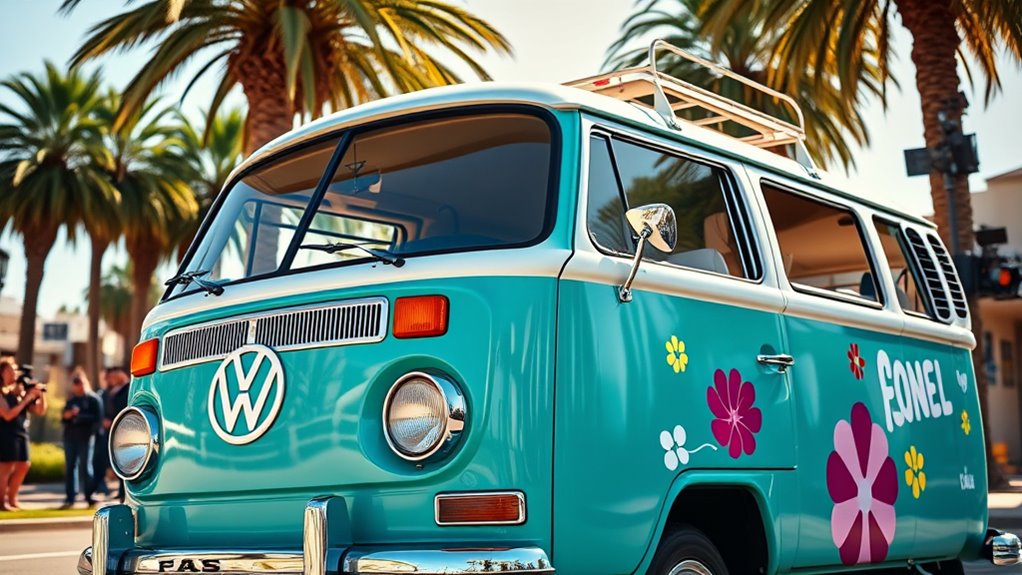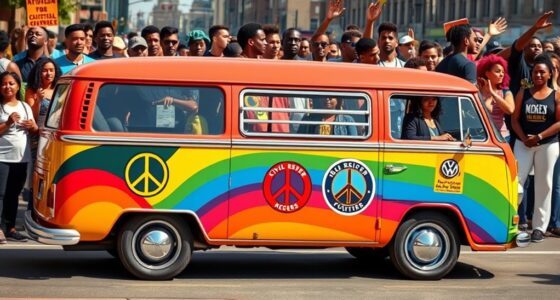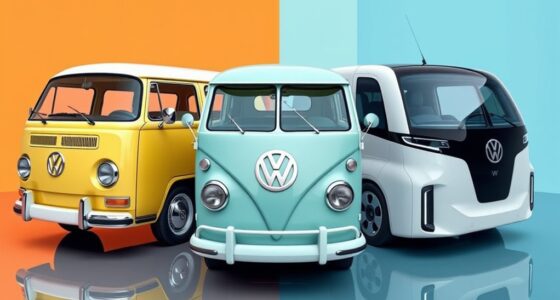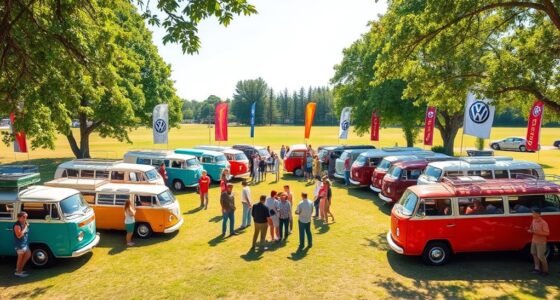The VW Bus has long been a symbol of freedom, rebellion, and nostalgia in pop culture. From its role in the 1960s hippie movement to iconic Hollywood films like *Little Miss Sunshine*, it captures themes of adventure and community. Its distinctive retro design continues to inspire music, TV shows, and modern revival efforts like the electric ID. Buzz. If you want to discover how this classic vehicle shaped generations, keep exploring its fascinating cultural journey.
Key Takeaways
- The VW Bus symbolizes counterculture, peace, and freedom, prominently featured in 1960s hippie movements and Woodstock imagery.
- It has been a staple in Hollywood films like *Little Miss Sunshine* and *The Karate Kid*, emphasizing themes of family and resilience.
- The Bus’s distinctive retro design and cultural symbolism have made it an iconic visual motif in movies and TV shows.
- Music references like The Who’s *Magic Bus* highlight its association with adventure, rebellion, and youth culture.
- Modern reinterpretations, such as the electric ID. Buzz, continue to honor its pop culture legacy while embracing innovation.
The Rise of the VW Bus as a Counterculture Icon

The VW Bus became a counterculture icon because it embodied rebellion against mainstream values and consumerism. Originally developed as a sibling to the Nazi-era Beetle for mass mobility, it was embraced by those rejecting Detroit’s gas-guzzling cars.
Its affordability and repairability supported self-sufficient, anti-capitalist communities. The bus symbolized opposition to Cold War militarism and commercialism, aligning with Timothy Leary’s “turn on, tune in, drop out” philosophy.
It served as transportation for Woodstock, protests against the Vietnam War, and civil rights rallies. Its murals and custom paint jobs expressed peace, love, and anti-war messages.
Its modular interior and reliability made it ideal for cross-country trips, communal living, and activism, cementing its status as a powerful symbol of rebellion and counterculture ideals.
Transformations in Design and Customization
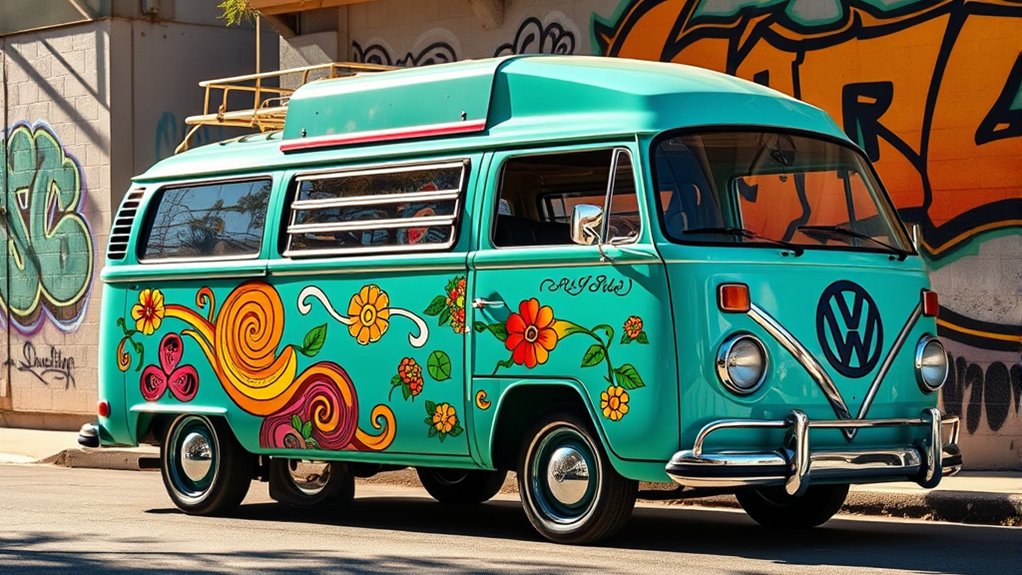
Over the decades, the VW Bus’s design and customization options have evolved dramatically, reflecting its cultural significance and adaptability. Its original design featured a split windshield in 1950, improving visibility and giving it a distinctive look.
The rear-mounted air-cooled engine, borrowed from the VW Beetle, provided simplicity and reliability, while unibody construction kept it lightweight and durable. Multiple configurations, like panel vans, kombis, and microbuses, served various needs. Hydrocolloid patches became a popular innovation in skincare, paralleling how the VW Bus was continually adapted for new lifestyles.
Factory modifications, such as Westfalia camper conversions with pop-tops and fold-out beds, boosted its appeal for travelers. Aftermarket trends included DIY interior setups, psychedelic paint schemes, lowered suspensions, and performance upgrades. As technology advanced, newer models incorporated fuel injection systems, which enhanced engine efficiency and performance, further expanding its versatility and appeal.
Additionally, the popularity of the VW Bus has been influenced by its global economic impact, which contributed to its iconic status and adaptability across different markets. Modern restorations and custom builds often incorporate advanced technology to meet contemporary standards while preserving its nostalgic charm.
The VW Bus’s Role in Hollywood and Cinema
Throughout cinema history, the VW Bus has become more than just a mode of transportation; it’s a powerful visual symbol that enriches storytelling and character development. You’ll notice it often plays a central role, influencing plot and family dynamics, like in *Little Miss Sunshine*, where it embodies unity and resilience. Its alimony laws influence how characters navigate relationships and separations, adding depth to narratives involving family conflicts. The bus’s retro aesthetic adds nostalgic charm and helps set the tone for period films. Its cross-cultural recognition makes it a versatile prop across genres. Films sometimes highlight its mechanical quirks, creating tension and character depth. Additionally, its cultural symbolism enhances its importance as an iconic element in cinematic storytelling. The VW Bus also evokes emotional connections with audiences, symbolizing adventure, freedom, and nonconformity. Its memorable appearances have cemented its status as a cinematic icon, influencing costume, set design, and pop culture’s collective memory. Moreover, vehicle design contributes to its enduring appeal and iconic status in film history. The nostalgic appeal of the VW Bus often helps filmmakers evoke specific eras and emotional resonance in viewers.
Celebrated in Music and Television
Music and television have long celebrated the iconic VW Bus as a symbol of freedom, nostalgia, and counterculture. Songs like The Who’s *Magic Bus* highlight its connection to adventure and rebellion, while Jake Owen’s *VW Van* blends country with pop to evoke carefree road trips. Its distinctive design has become an instantly recognizable vehicle icon that continues to inspire generations. TV shows like *Full House* and *The Karate Kid* feature VW Buses to emphasize family and youthful spirit. Additionally, *Family Guy* humorously references them in various episodes. At music festivals like Woodstock, VW Buses became symbols of peace and freedom. Modern events also incorporate them as nostalgic décor. From Snoop Dogg’s music videos to advertising campaigns, the VW Bus remains a cultural icon. Its presence in music and TV continues to evoke a sense of freedom, community, and retro charm.
Its Enduring Presence in Art and Literature
The VW Bus’s influence extends beyond music and television, inspiring a rich array of art and literary works that celebrate its cultural significance. Artists like Bob Hieronimus have popularized painted VW Buses, turning them into vibrant, movable art pieces adorned with cultural symbols. These buses often reflect counterculture themes, embodying rebellion, peace, and freedom. The vehicle’s iconic status has also led to numerous artistic representations and collectibles that continue to inspire new generations. In literature, they appear in stories of the 1960s, symbolizing nonconformity and adventure, and are featured in memoirs of hippie travelers and musicians. Photographs of VW Buses, especially at iconic events like Woodstock, have become symbols of youth and resistance. Artistic renderings incorporate peace signs, flowers, and revolutionary imagery, cementing the bus’s status as a powerful cultural icon and historical landmark. Moreover, the continued popularity of the VW Bus has fostered a nostalgic revival within contemporary pop art, blending nostalgic imagery with modern commentary.
The Cultural Legacy and Nostalgia Surrounding the Bus
The VW Bus’s legacy as a symbol of freedom and nostalgia endures, capturing the imagination of both older enthusiasts and new generations. You see it as a representation of adventure, travel, and self-expression, thanks to its versatile design and distinct features like the split windshield and two-tone paint. Its association with the hippie movement, peace, and love makes it an icon of counterculture, while its role in surf and beach culture reinforces its laid-back, explorative spirit. You can spot it in movies, music festivals, and nostalgic retrospectives, fueling admiration and longing. Additionally, its presence in popular media has cemented its place in cultural history. Today, enthusiasts restore and customize vintage models, and modern versions like the VW ID. Buzz aim to preserve its timeless appeal while embracing innovation. The bus remains a powerful symbol of freedom and cultural identity, embodying its cultural legacy that continues to inspire. Its enduring popularity is also reflected in the collectible car market, where vintage models are highly sought after.
Contemporary Influence and Revival of the Iconic Vehicle
The VW Bus’s iconic status continues to influence modern media and design, symbolizing freedom and adventure across various platforms. You’ll see it in films and TV shows that evoke a sense of exploration and nostalgia. Its distinctive flat front and large windows have inspired contemporary automotive styling, blending retro charm with modern innovation. The Bus’s versatility makes it a favorite for road trips and camping, fueling its cultural relevance. Volkswagen’s ID. Buzz reimagines the classic as a sleek, electric minivan, maintaining nostalgic appeal while embracing cutting-edge technology. With features like dual-motor all-wheel drive and a 231-mile range, it appeals to new and loyal fans alike. The ID. Buzz’s blend of history and innovation cements the Bus’s place in today’s evolving automotive culture, showcasing how cultural symbolism continues to shape vehicle design and identity. Additionally, its enduring popularity highlights the vehicle’s significance as a timeless icon that resonates across generations. Its influence also extends into the global economic realm, where the revival of the model reflects broader trends in automotive innovation and sustainability. Incorporating elements of sustainable design and electric mobility, the new models ensure that the VW Bus remains relevant in a rapidly changing industry.
Frequently Asked Questions
How Did the VW Bus Become a Symbol of Counterculture Movements Globally?
You see, the VW Bus became a global symbol of counterculture because it represented freedom, community, and rebellion. Its affordable, customizable design made it perfect for protests, music festivals, and nomadic lifestyles.
As you observe, artists and activists painted it with slogans and art, embedding it in social movements. Hollywood and media further cemented its rebellious image, inspiring generations to see it as an icon of non-conformity and social change.
What Are Some Unique Modifications Owners Have Made to Personalize Their VW Buses?
You’ve got a vision for making your VW bus stand out, and owners go the extra mile. You can add off-road lifts, vibrant paint jobs, or custom wheels to turn heads. Inside, you might install premium sound systems or cozy interiors.
Mechanical upgrades like better ignition or lighting boost performance. The key is to let your personality shine—think of it as putting your stamp on a classic, making it uniquely yours.
Which Famous Movies or TV Shows Prominently Featured the VW Bus?
You’ll notice the VW Bus shown prominently in movies like *Fast Times at Ridgemont High*, *Back to the Future*, and *Bill & Ted’s Excellent Adventure*.
TV shows like *Parks and Recreation*, *Futurama*, and *My Name Is Earl* also feature it.
These appearances highlight its role as a symbol of freedom, adventure, and nostalgia, making it an iconic fixture in pop culture across different media.
How Has the VW Bus Influenced Modern Vehicle Design and Lifestyle Branding?
You might wonder how a simple vehicle could shape modern design and branding. The VW Bus’s influence is profound, blending retro charm with futuristic tech like the ID. Buzz.
It inspires versatile, eco-friendly vehicles and a lifestyle that champions freedom and authenticity. Its nostalgic aesthetic and cultural symbolism continue to resonate, fueling marketing strategies that evoke rebellion, adventure, and sustainability—making the VW Bus an enduring icon shaping both cars and identities today.
What Efforts Are Being Made to Preserve and Restore Vintage VW Buses Today?
You’re seeing many efforts to preserve and restore vintage VW buses today. Restoration specialists use advanced rust treatments, epoxy primers, and hybrid joining methods to guarantee durability.
They focus on precise panel fitting, electrical modernization, and engine rebuilding for performance. Community forums, tutorials, and expert consultations guide you through sourcing parts and techniques.
Conclusion
As you reflect on the VW bus’s journey from 1960s counterculture to modern nostalgia, it’s like holding onto a Polaroid of a carefree summer day. Its vibrant spirit continues to inspire, reminding you that even in a world racing towards the future, some icons never fade—they just turn into timeless legends, waiting for you to hop in and chase the sunset once again.
